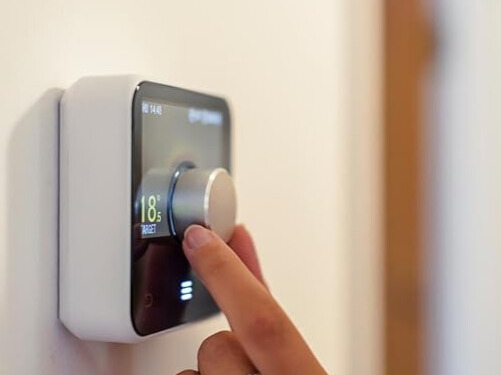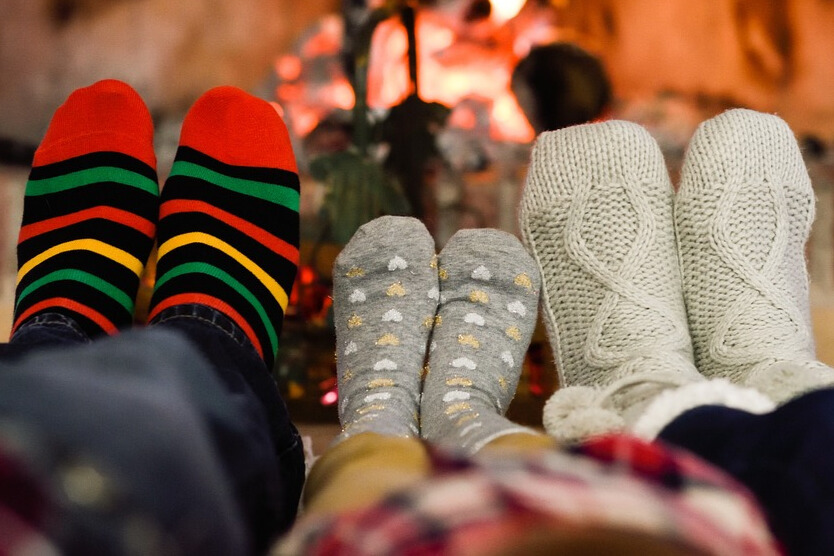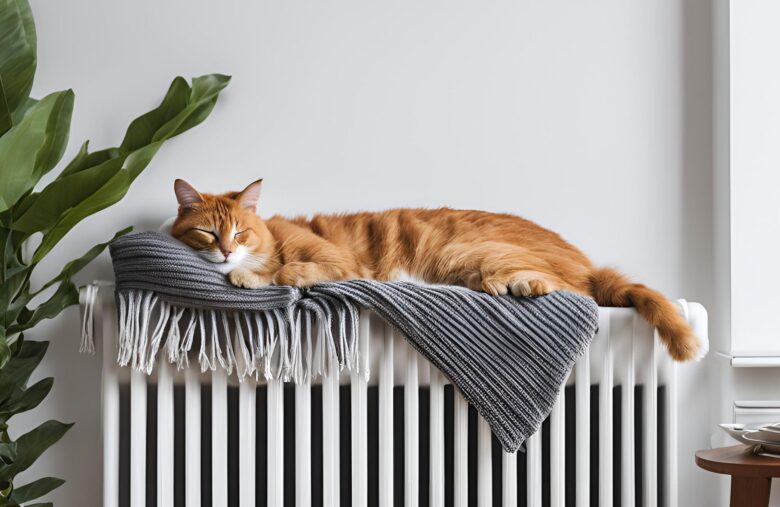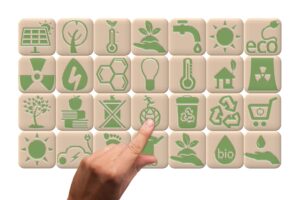Winter is a wonderland, but for many of us, it can send our energy bills skyrocketing. Did you know that small changes can make a big difference for both your wallet and the planet? In this guide, we’ll explore 10 low-cost and easy-to-implement energy-saving tips that you can try at home right away, helping you lower your energy bill while reducing your carbon footprint. Let’s get cosy and eco-friendly this winter!
1. Adjust Your Thermostat to Stay Cosy and Green
The most energy we use at home is heating, taking up nearly 50% of an average household energy bill. Lowering the thermostat by just 1-2 degrees could save you up to £113 annually and cut your household’s carbon emissions by 310kg.
Set the thermostat as low as is comfortable. The government recommends a minimum room temperature of 18°C though older people or vulnerable groups may need a warmer environment.

Use a smart thermostat to control your heating schedule precisely, a game-changer for winter energy saving. Though installation costs (including unit and labour) can range from £150 to £350, it can save around 10%-12% on your heating bill. And don’t forget to set it on holiday mode when you’re going away for a while.
2. Stop Heat Loss by Sealing Draughts

Warm air escapes and cold air sneaks in through draughts in homes, such as around doors and windows, gaps in the floor, or up the chimney. Draught-proofing is one of the cheapest and most effective ways to save energy. While professional draught-proofing can cost around £200, you can tackle this with some simple DIY fixes:
- Add draught-proofing strips or caulk around leaky doors and windows. You can easily find these materials at your local hardware store.
- Use draught stoppers or just rolled-up towels for external doors.
- Hang thermal curtains, especially for large windows, to keep heat in.
3. Get the Most Out of Your Radiator

Maximising your radiator’s efficiency can lead to significant energy savings. Consider using radiator reflector panels, a great low-cost option to reduce your energy consumption. They are foil panels put behind radiators, reflecting heat back into the room instead of letting it escape through external walls. If you’re looking to save money, kitchen foil can work just as well!
Additionally, air can seep into your central heating and tend to bubble up to the top of your radiators over time, especially upstairs. This air can affect the efficiency of your radiators and also make the radiators noisy. Release trapped air in your radiators to make them more efficient and quieter.
4. Dress Warm with Thermal Pieces

Staying warm and cosy in winter doesn’t have to mean cranking up the heat, you can easily lower your thermostat without feeling cold by layering up!
Thermal jumpers, loungewear and socks are great pieces to keep warm in winter. Consider choosing those made from sustainable fabrics, such as responsible wool, organic cotton and recycled materials. While fleece is a popular choice for warmth, it’s primarily made from polyester – a synthetic fibre derived from petroleum – essentially, it’s plastic. Try to avoid polyester and opt for pre-loved pieces instead, you might be surprised at the lovely finds available at your local charity shops or platforms like Vinted.
Bonus Tip: Low Energy Heating Devices

Electric blankets and heated throws can warm you up quickly without needing to heat the entire house, especially at night. Though they still require electricity, electric blankets disperse heat through built-in wires and consume little energy. According to Octopus Energy, an energy-efficient electric blanket can heat a person for just 2p to 4p an hour, vastly reducing winter heating bills and carbon emissions. Modern electric blankets are safe and energy efficient, costing £40 on average but can save you up to £300 on bills.
5. Reduce Your Combi Boiler Flow Temperature to 60°C

If you have a combi boiler, turning down the flow temperature to 60°C or below can save you money and reduce energy waste in your home. This is because combi boilers tend to capture and recycle heat less efficiently at higher temperatures, which means they require more gas to heat your home.
An analysis by National Grid revealed that if 10 million households turned down the flow temperature on their combi boilers to 60°C or below, it could wipe £1 billion off UK energy bills and save 1.7 million tonnes of carbon emissions – the equivalent of nearly six million transatlantic flights! That’s a significant impact for such a straightforward change.
6. Overfilled Kettle? Store Boiled Water in Thermos Flasks

Did you know that kitchen appliances account for around 4% of a typical energy bill? Kettles are among the biggest energy guzzlers, as they’re commonly overfilled. We’ve all been there, boiling water for a single cup of tea only to end up pouring most of it down the sink. And let’s face it, when it’s chilly outside, there’s nothing better than cosying up with a delicious hot chocolate, topped with cream and marshmallows.
Investing in a thermos flask can help reduce this waste. A quality 1.2L thermos flask costs around £25 and can keep your leftover boiled water hot for up to 24 hours. This tip is particularly handy for those working from home or anyone who spends a lot of time at home. By reducing how often you boil water, you’ll see savings in both your energy bill and carbon emissions.
7. Unplug Standbys

Electronics still consume power when plugged in, even when they’re not in use – this is known as the phantom effect. Studies show that 45% of British households leave appliances on standby. The average energy consumed by standbys can account for 9% – 16% of a home’s total energy bill.
Some typical so-called ‘Vampire Devices’ include:
- Smart speakers and smart home devices
- Set top boxes and recorders
- TVs and game consoles
- Microwaves
- Phones, tablets, computers and laptops left on charge
For a quick and easy action, unplug your phone, laptop and other small electronics once they’re fully charged to reduce energy waste. Use power strips for easy unplugging of multiple items at one time or opt for smart plugs that automatically cut power.
8. Switch to LED Lights

Shorter days mean more lighting is used, switching to energy-efficient options helps lower bills and greenhouse gas emissions. LED lights can save up to 90% of energy and last 25 times longer than traditional bulbs.
Lighting makes up 11% of the average UK household electricity consumption. By replacing incandescent bulbs with high energy-efficient LED lights, especially in high-use areas like living rooms and kitchens, you’ll quickly notice a difference in your energy bills.
Check the new EU and UK energy rating labels on LED packaging, which now rate from A to G instead of the previous A to A+++. This helps you find the right balance between energy efficiency and brightness for your needs. Don’t forget about outdoor and festival lights! Using timers and sensors can further reduce energy waste and carbon footprint.
9. Dry Your Clothes Smartly

Washing clothes adds a surprising amount to your energy bill and carbon footprint – but tumble drying them racks up even more. A typical 40°C wash and tumble drying generates 2.4kg CO2e (carbon dioxide equivalent), with nearly three-quarters of the carbon footprint coming from the drying rather than the washing. In addition, tumble dryers are one of the main sources of microfiber pollution in the atmosphere – a single tumble dryer could release 120m of microplastic fibres into the air each year, according to a study.
Instead of using a tumble dryer, consider these smarter drying alternatives:
- Dry outside when the sun is out.
- Set your washing machine to the fastest spin possible to remove excess water, making clothes much quicker and easier to dry.
- Put your clothes airer in a warm and dry place at home, such as a south-facing room upstairs.
- Locate your clothes airer near the radiator so the heat can get into the room while drying your laundry. Make sure to leave some space between the airer and the radiator to allow for airflow. Do not put the airer directly on a radiator or block it, as it can confuse the thermostat and cause the radiator to pump out extra heat.
- Consider investing in a heated airer with a timer, costs from £40 and generally uses significantly lower energy than a typical tumble dryer.
10. Take Advantage of Heat from the Sun

Why not make the most of free solar energy whenever the sun is shining? Open the curtains in your south-facing rooms during the day to let in natural warmth. It’s especially handy if you work from home – grab your laptop and coffee, and settle into the sunniest spot. Not only will you soak up some vitamin D, but you’ll also enjoy the natural heat, both for free!
To summarise, these 10 low-cost winter energy-saving tips can help you reduce both your energy bill and carbon footprint, all while staying cosy at home. They’re quick, simple, and affordable, so why not start by trying one or two tips today? A few small changes can make a big difference for your wallet and the planet this winter!
To support the running costs of this blog, this post contains affiliate links. This means Green Is Happening may earn a small commission, at no extra cost to readers, on items purchased through these links.



